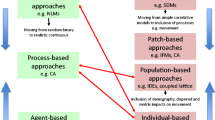Abstract
Spatially explicit ecological models offer numerous surprises, ranging from intricate tapestries of spatial patterning to widespread extinction when roads or deforestation fracture a landscape. Many of the gloomier examples involve thresholds, the approach to which would be hard to anticipate with standard census data. The challenge is in making a constructive management tool from these abstract harbingers of ecological disruption.
Similar content being viewed by others
References
Groom, M. & Schumaker, N. in Biotic Interactions and Global change (eds Kareiva, P., Kingsolver, J. & Huey, R.) 24–44 (Sinauer, Sunderland, 1993).
Noss, R. & Csuti, B. in Principles of Conservation Biology (eds Meffe, G. & Carroll, C.) 237–264 (Sinauer, Sunderland, 1994).
Hastings, A. & Higgins, K. Science 263, 1133–1136 (1994).
Tilman, D., May, R., Lehman, C. & Nowak, M. Nature 371, 65–66 (1994).
Sabelis, M. & Diekmann, O. Theor. Pop. Biol. 34, 169–176 (1988).
Taylor, A. in Metapopulation Dynamics: Empirical and Theoretical Investigations (eds Gilpin, M. & Hanski, I.) 305–323 (Academic, London, 1991).
Nachman, G. in Metapopulation Dynamics: Empirical and Theoretical Investigations (eds Gilpin, M. & Hanski, I.) 285–303 (Academic, London, 1991).
Turner, M. et al. Ecol. Appl. (in the press).
Caswell, H. Am. Nat. 122, 127–154 (1978).
Hanski, I. Trends Ecol. Evol. 9, 131–135 (1994).
Levins, R. Bull. entomol. Soc. Am. 15, 273–240 (1969).
Hanski, I. & Gilpin, M. in Metapopulation Dynamics: Empirical and Theoretical Investigations (eds Gilpin, M. & Hanski, I.) 3–16 (Academic, London, 1991).
Nee, S. Nature 367, 123–124 (1994).
Anderson, R. & May, R. Infectious Diseases of Humans (oxford Univ. Press, 1992).
Lande, R. Oecologia 75, 601–607 (1988).
Noon, B. & McKelvey K. in The California Spotted Owl: a Technical Assessment of its Current Status (eds Verner, J. et al.) 187–206 (Forest Service USDA, Albany, California, 1992).
McKelvey, K., Noon, B. & Lamberson, R. in Biotic Interactions and Global Change (eds Kareiva, P., Kingsolver, J. & Huey, R.) 424–450 (Sinauer, Sunderland, 1993).
Liu, J., Dunning, J. & Pulliam H. Cons. Biol. (in the press).
Pulliam, H. et al. Ecol. Appl. 2, 165–177 (1992).
Pulliam, H. et al. Ibis (in the press).
Conroy, M. et al. Ecol Appl. (in the press).
Hastings, A. Theor. Pop. Biol. 18, 363–373 (1980).
Horn, H. & MacArthur, R. Ecology 53, 749–752 (1972).
Nee, S. & May, R. J. anim. Ecol. 61, 37–40 (1992).
Tilman, D. Ecology 75, 2–16 (1994).
Caswell, H. & Cohen, J. in Metapopulation Dynamics: Empirical and Theoretical Investigations (eds Gilpin, M. & Hanski, I.) 193–218 (Academic, London, 1991).
Fahrig, L. & Merriam, G. Cons. Biol. 8, 50–59 (1994).
Kareiva, P. Phil. Trans. R. Soc. B330, 175–190 (1990).
Hassell, M., Comins, H. & May, R. Nature 370, 290–292 (1994).
Comins, H., Hassell, M. & May, R J. anim. Ecol. 61, 735–748 (1992).
Hassell, M., Godfray, H. & Comins, H. in Biotic Interactions and Global Change (eds Kareiva, P., Kingsolver, P. & Huey, R.) 402–423 (Sinauer, Sunderland, 1993).
Durrett, R. & Levin, S. Theor. Pop. Biol. 46, 363–394 (1994).
May, R. in Large-scale Ecology and Conservation Biology (eds Edwards, P., May, R. & Webb, N.) 1–17 (Blackwell, Oxford, 1994).
Harrison, S., Stahl, A. & Doak, D. Cons. Biol. 7, 950–953 (1994).
Scott, J. M. et al. Gap Analysis: a Geographic Approach to Protection of biological Diversity, Wildlife Monographs No. 123 (Wildlife Society and USFWS 41, Blacksburg, Virginia, 1993).
Paine, R. Marine Rocky Shores and Community Ecology: an Experimentalist's Perspective (Ecology Institute, Oldendorf, Germany, 1994).
Dushoff, J. & Levin, S. Math. Biosci. (in the press).
Dunning, J. et al. Ecol. Appl. (in the press).
Author information
Authors and Affiliations
Rights and permissions
About this article
Cite this article
Kareiva, P., Wennergren, U. Connecting landscape patterns to ecosystem and population processes. Nature 373, 299–302 (1995). https://doi.org/10.1038/373299a0
Issue Date:
DOI: https://doi.org/10.1038/373299a0
- Springer Nature Limited
This article is cited by
-
Tigers on the edge: mortality and landscape change dominate individual-based spatially-explicit simulations of a small tiger population
Landscape Ecology (2022)
-
Buddhist monasteries facilitated landscape conservation on the Qinghai-Tibetan Plateau
Landscape Ecology (2022)
-
Factors affecting butterfly and plant diversity in basiphilous dry grasslands of Transylvania, Romania
Community Ecology (2021)
-
Global stability of an age-structured population model on several temporally variable patches
Journal of Mathematical Biology (2021)
-
Trajectory assessment of the vulnerable marsupial Dromiciops gliroides in the Patagonian temperate forest
Mammalian Biology (2021)




